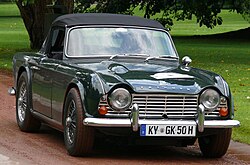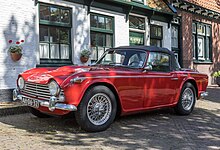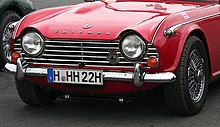Triumph TR4
| triumph | |
|---|---|
| TR 4 | |
| Production period: | 1961-1967 |
| Class : | Sports car |
| Body versions : | Roadster |
| Engines: |
Otto engine : 2.2 liters (74 kW) |
| Length: | 3962 mm |
| Width: | 1460 mm |
| Height: | 1270 mm |
| Wheelbase : | 2235 mm |
| Empty weight : | 1010 kg |
| Previous model | Triumph TR3A |
| successor | Triumph TR5 |
The Triumph TR 4 was a roadster produced by the British car manufacturer Triumph from 1961 to 1965 , which initially largely corresponded technically to the previous model TR 3A . Significant improvements compared to its predecessor were introduced with the TR 4A 1965. By the end of production on August 2, 1967 and the replacement by the TR 5 , a total of 68,717 vehicles were built in the TR4 series, 40,253 of which were TR 4 and 28,465 TR 4A.
history
The TR 4 with a body designed by the Italian automobile designer Giovanni Michelotti was presented in 1961. The box frame with cross bracing, the chassis with double wishbones at the front and rigid axle on leaf springs at the rear, as well as the engine with a displacement increased to 2138 cm³ and an output of 100 PS (74 kW) were taken over from the TR 3 slightly modified. There was also a through hole for a crank handle in the radiator grille. The transmission had four gears and was fully synchronized. The significantly widened track and interior as well as rack and pinion steering instead of the earlier worm- roller steering were new . Furthermore, the cumbersome plug-in windows of the predecessor gave way to crank windows. In addition, the TR 4 was the first production vehicle to have adjustable ventilation ducts in the dashboard.
At an affordable price, the TR 4 offered performance that was only a little inferior to other sports cars. It accelerated from zero to 100 km / h in 12 seconds and reached a top speed of 174 km / h.
A two-part hardtop, available at an additional cost of DM 1,100, turned the classic roadster into an attractive coupé. It was called "Surrey Top" by Triumph; it consists of a firmly screwed panoramic rear window and two interchangeable roof parts made of metal or soft top fabric. Porsche took up this idea in 1965 and implemented it with the Porsche 911 Targa . Wire-spoke wheels with central locking instead of the standard pressed steel disc wheels were also available at an additional cost.
The TR 4A
The body of the TR 4A was based on its predecessor, the TR 4. In 1965, new approval regulations in the USA, the most important market for the TR 4, forced the company to install front direction indicators and position lights on the side of the fenders. They were integrated into chrome-plated attachments, each with a decorative strip that ran over the doors to the rear. Smaller bumper horns at the front and a modified hood emblem in the form of a globe rounded off the external changes.
A new chassis with rear independent wheel suspension on semi-trailing arms, similar to the one in the Triumph 2000 sedan, was hidden under the body instead of the rigid axle. The coil springs at the rear were designed to be softer than the leaf springs before. The unsprung masses were lower, which made driving a little more comfortable. The addition IRS on some TR 4A indicates the rear independent wheel suspension or independent rear suspension . At the request of the then US importer, part of the TR4A production was still built with the rigid axle of the TR 4 in order not to let the price of the sports car rise. Of the total of 28,465 TR 4A built, an estimated 10,000 units with the rigid axle were delivered in the USA.
Smaller changes to the engine and exhaust system made it possible to increase the output to 104 hp (76 kW). The weight increased to 1035 kg. The top speed remained at around 175 km / h.
The TR 4A got new seats, a now standard wooden dashboard, the operation of the handbrake was relocated to the transmission tunnel between the seats. The new convertible top, which was modified from the Triumph Herald, was screwed tightly at the rear and made it much easier and faster to operate, brought a further improvement.
Conversions Dové GTR 4
Around 50 copies of the TR 4 and TR 4A were converted in spring 1963 by Thomas Harrington Coach Builders into hatchback coupés with a large tailgate. They were similar to the Harrington Alpine coupes that Harrington had been making since 1961 on the basis of the Sunbeam Alpine . The modifications of the TR 4 were based on an order from the London Triumph dealer Dové, who sold them as the Dové GTR 4 Coupé and GTR 4A Coupé.
Motorsport
The TR 4 was used in international rallying as well as in many national racing events. Triumph itself fielded four TR4 factory rally cars between 1962 and 1964 in major international rallies such as the Coupe des Alpes, the Tulip Rally, Liége-Sofia-Liége, RAC Rally, Rallye Monte Carlo and Shell 4000 with varying degrees of success. At national racing events in England, but above all in the USA, the TR 4 also showed its potential as a racing car. Its neutral driving behavior and a very favorable weight distribution regularly ensured the win of the production classes in the USA.
The Triumph TR 4 is still used successfully in motorsport today.
Technical specifications
| Parameters | TR 4 | TR 4A |
|---|---|---|
| engine | 4-cylinder four-stroke in- line engine at the front | |
| Displacement | 2138 cc | |
| Bore × stroke | 86 × 92 mm | |
| compression | 9.0: 1 | |
| power | 74 kW (100 PS) at 4600 rpm | 76 kW (104 PS) at 4700 rpm |
| Max. Torque | 172 Nm at 3350 rpm | |
| Valve control | side camshaft (chain driven), bumpers and rocker arms | |
| cooling | Water cooling | |
| Carburetor | 2 Zenith Stromberg carburettors (Ø 44 mm) | |
| transmission | 4-speed gearbox (with overdrive on request ), fully synchronized, center shift; Rear wheel drive |
|
| Front suspension | Triangular wishbones with coil springs, telescopic shock absorbers and anti-roll bar |
|
| Rear suspension | Rigid axle on semi-elliptical leaf springs, piston shock absorbers |
Semi-trailing arm with coil springs, lever damper |
| body | Sheet steel body and box frame with cross bracing (screwed to the body) |
|
| steering | Rack and pinion steering | |
| brake | Front disc brake, rear drum brake, hydraulically operated |
|
| wheelbase | 2235 mm | 2240 mm |
| Front track | 1245 mm | |
| Rear track | 1220 mm | 1232 mm |
| wheel size | 5.90-15 | |
| Dimensions L × W × H | 3960 × 1460 × 1270 mm | 3960 × 1470 × 1270 mm |
| Empty weight (without driver) | 1010 kg | 1035 kg |
| maximum weight allowed | 1400 kg | |
| Top speed | approx. 175 km / h | |
Web links
Individual evidence
- ↑ http://www.autogericke.de/sportwagen/167/triumph_tr4_tr_4.html
- ↑ http://www.conceptcarz.com/vehicle/z7304/Triumph_TR4/default.aspx
- ↑ Price in Die Automodelle 1963/64 , Vereinigte Motorverlage: 11,990 DM (Porsche 1600 SC, 75 PS, 175 km / h: 14,950 DM)
- ↑ Measurement of auto, motor and sport
- ↑ ateupwithmotor.com/model-histories/triumph-2000-mk1/2/
- ↑ http://www.tr-register.at/tr4tr5tr250.html








